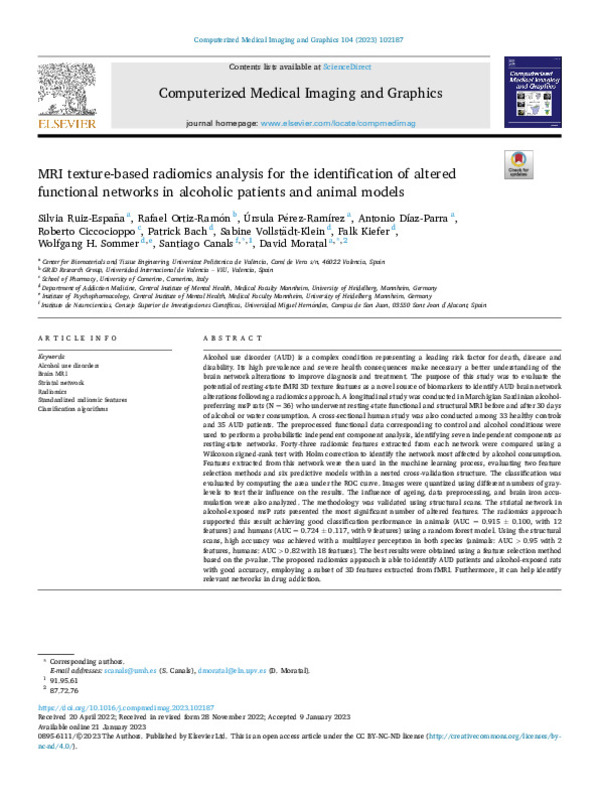JavaScript is disabled for your browser. Some features of this site may not work without it.
Buscar en RiuNet
Listar
Mi cuenta
Estadísticas
Ayuda RiuNet
Admin. UPV
MRI texture-based radiomics analysis for the identification of altered functional networks in alcoholic patients and animal models
Mostrar el registro sencillo del ítem
Ficheros en el ítem
| dc.contributor.author | Ruiz-España, Silvia
|
es_ES |
| dc.contributor.author | Ortiz-Ramón, Rafael
|
es_ES |
| dc.contributor.author | Pérez-Ramírez, María Úrsula
|
es_ES |
| dc.contributor.author | Díaz-Parra, Antonio
|
es_ES |
| dc.contributor.author | Ciccocioppo, Roberto
|
es_ES |
| dc.contributor.author | Bach, Patrick
|
es_ES |
| dc.contributor.author | Vollstädt-Klein, Sabine
|
es_ES |
| dc.contributor.author | Kiefer, Falk
|
es_ES |
| dc.contributor.author | Sommer, Wolfgang H.
|
es_ES |
| dc.contributor.author | Canals, Santiago
|
es_ES |
| dc.contributor.author | Moratal, David
|
es_ES |
| dc.date.accessioned | 2024-04-11T09:56:53Z | |
| dc.date.available | 2024-04-11T09:56:53Z | |
| dc.date.issued | 2023-03 | es_ES |
| dc.identifier.issn | 0895-6111 | es_ES |
| dc.identifier.uri | http://hdl.handle.net/10251/203363 | |
| dc.description.abstract | [EN] Alcohol use disorder (AUD) is a complex condition representing a leading risk factor for death, disease and disability. Its high prevalence and severe health consequences make necessary a better understanding of the brain network alterations to improve diagnosis and treatment. The purpose of this study was to evaluate the potential of resting-state fMRI 3D texture features as a novel source of biomarkers to identify AUD brain network alterations following a radiomics approach. A longitudinal study was conducted in Marchigian Sardinian alcoholpreferring msP rats (N = 36) who underwent resting-state functional and structural MRI before and after 30 days of alcohol or water consumption. A cross-sectional human study was also conducted among 33 healthy controls and 35 AUD patients. The preprocessed functional data corresponding to control and alcohol conditions were used to perform a probabilistic independent component analysis, identifying seven independent components as resting-state networks. Forty-three radiomic features extracted from each network were compared using a Wilcoxon signed-rank test with Holm correction to identify the network most affected by alcohol consumption. Features extracted from this network were then used in the machine learning process, evaluating two feature selection methods and six predictive models within a nested cross-validation structure. The classification was evaluated by computing the area under the ROC curve. Images were quantized using different numbers of graylevels to test their influence on the results. The influence of ageing, data preprocessing, and brain iron accumulation were also analyzed. The methodology was validated using structural scans. The striatal network in alcohol-exposed msP rats presented the most significant number of altered features. The radiomics approach supported this result achieving good classification performance in animals (AUC = 0.915 +/- 0.100, with 12 features) and humans (AUC = 0.724 +/- 0.117, with 9 features) using a random forest model. Using the structural scans, high accuracy was achieved with a multilayer perceptron in both species (animals: AUC > 0.95 with 2 features, humans: AUC > 0.82 with 18 features). The best results were obtained using a feature selection method based on the p-value. The proposed radiomics approach is able to identify AUD patients and alcohol-exposed rats with good accuracy, employing a subset of 3D features extracted from fMRI. Furthermore, it can help identify relevant networks in drug addiction. | es_ES |
| dc.description.sponsorship | This work was supported by the European Union's Horizon 2020 research and innovation program (668863-SyBil-AA) and the ERA-NET NEURON program (FKZ 01EW1112-TRANSALC and PIM2010ERN-00679), as well as the Spanish State Research Agency through the Severo Ochoa Program for Centres of Excellence in R & D (SEV-2017-0723). S. C. acknowledges financial support from the Ministerio de Economia y Competitividad (MINECO) under grant PGC2018-101055-B-I00. D.M. and S.C. acknowledge financial support from the Generalitat Valenciana through the Prometeo Program (PROMETEO/2019/015). Additional support was given to W.H.S by the Deutsche Forschungsgemeinschaft Center grant TRR 265 (Heinz et al., 2020) and the Bundesministerium fur Bildung und Forschung (BMBF; FKZ: 031L0190A, 01ZX1909CA). We thank Dr. Begona Fernandez for excellent technical assistance and Dr. Cecile Bordier for helping with the human data preprocessing. | es_ES |
| dc.language | Inglés | es_ES |
| dc.publisher | Elsevier | es_ES |
| dc.relation.ispartof | Computerized Medical Imaging and Graphics | es_ES |
| dc.rights | Reconocimiento - No comercial - Sin obra derivada (by-nc-nd) | es_ES |
| dc.subject | Alcohol use disorders | es_ES |
| dc.subject | Brain MRI | es_ES |
| dc.subject | Striatal network | es_ES |
| dc.subject | Radiomics | es_ES |
| dc.subject | Standardized radiomic features | es_ES |
| dc.subject | Classification algorithms | es_ES |
| dc.subject.classification | TECNOLOGIA ELECTRONICA | es_ES |
| dc.title | MRI texture-based radiomics analysis for the identification of altered functional networks in alcoholic patients and animal models | es_ES |
| dc.type | Artículo | es_ES |
| dc.identifier.doi | 10.1016/j.compmedimag.2023.102187 | es_ES |
| dc.relation.projectID | info:eu-repo/grantAgreement/EC/H2020/668863/EU | es_ES |
| dc.rights.accessRights | Abierto | es_ES |
| dc.contributor.affiliation | Universitat Politècnica de València. Escuela Técnica Superior de Ingenieros Industriales - Escola Tècnica Superior d'Enginyers Industrials | es_ES |
| dc.description.bibliographicCitation | Ruiz-España, S.; Ortiz-Ramón, R.; Pérez-Ramírez, MÚ.; Díaz-Parra, A.; Ciccocioppo, R.; Bach, P.; Vollstädt-Klein, S.... (2023). MRI texture-based radiomics analysis for the identification of altered functional networks in alcoholic patients and animal models. Computerized Medical Imaging and Graphics. 104. https://doi.org/10.1016/j.compmedimag.2023.102187 | es_ES |
| dc.description.accrualMethod | S | es_ES |
| dc.relation.publisherversion | https://doi.org/10.1016/j.compmedimag.2023.102187 | es_ES |
| dc.type.version | info:eu-repo/semantics/publishedVersion | es_ES |
| dc.description.volume | 104 | es_ES |
| dc.identifier.pmid | 36696812 | es_ES |
| dc.relation.pasarela | S\510266 | es_ES |
| dc.contributor.funder | European Commission | es_ES |
| dc.contributor.funder | Universitat Politècnica de València | es_ES |
| dc.subject.ods | 03.- Garantizar una vida saludable y promover el bienestar para todos y todas en todas las edades | es_ES |








